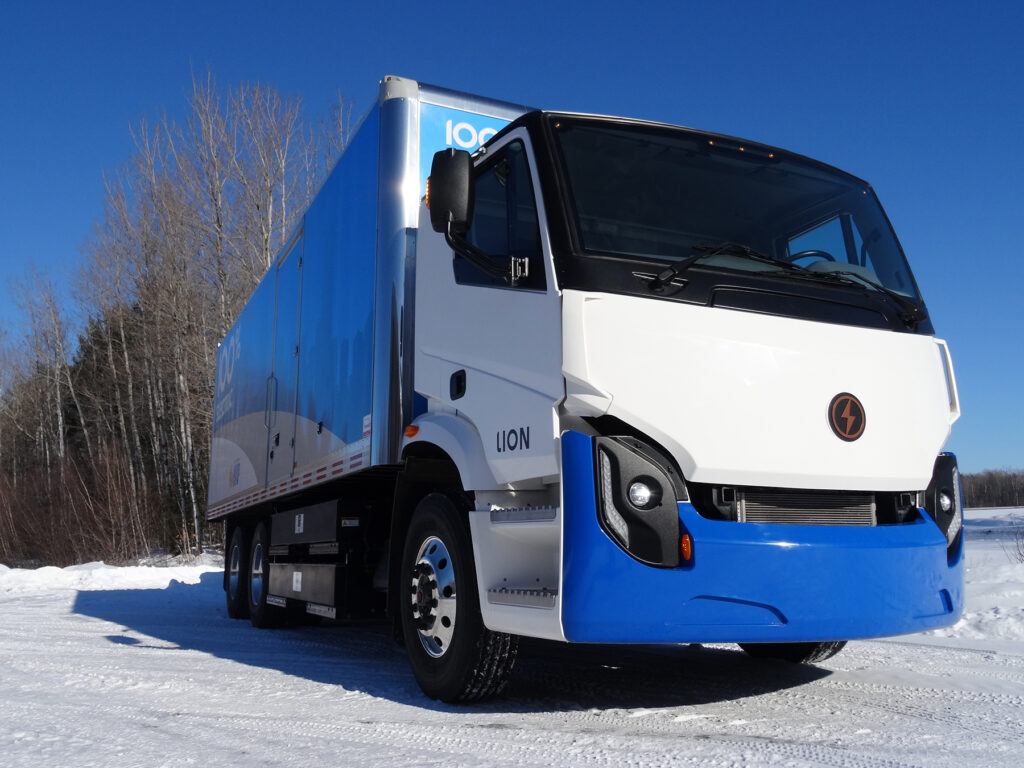One of the biggest questions most Canadian fleet owners have is how electric vehicles will perform in winter conditions.
The good news is that electric vehicles start more reliably in winter than their gas or diesel cousins. Another bonus: you can heat the cabin to a toasty temperature and defrost the vehicle while it’s plugged into a charger, without having to worry about exhaust while idling. On the other hand, even heat-pump-equipped electric vehicles will lose some of their range in the winter once the temperature drops below -5ºC, and most will lose closer to 45 per cent at -20ºC. You may also see the motor consuming more power on days when very icy conditions reduce traction.

Why do EVs lose range in winter?
There is a standard range curve that follows temperature that applies to all EVs. Geotab, a telematics company that tracks EV data, found that below 0ºC, vehicles typically start to lose about 20 per cent of their range and bottom out at -25ºC with as much as 50 per cent loss of range. This is primarily due to the auxiliary power required to keep the cabin warm.
Here’s why cabin conditioning is such a range-limiter: “It takes 5 kilowatts (kW) of power to run the powertrain of an electric vehicle,” says Matt Stevens, advisor for sustainability projects at Geotab. “The reason electric vehicles typically lose 50 per cent of their range in winter is that you need an additional 5 kW to heat the air in the cabin, on top of the 5 kW going to the wheels.” (Stevens has some tips on how to tackle this problem below.)
Battery performance is also affected by temperature – and the optimal operating temperature for an EV battery is between 15ºC and 25ºC. Most EVs have a battery thermal management system and as the battery warms up, the EV will recover range.
Winter range in the real world
To give you a sense of how this might affect fleet operations in real life, we spoke to several fleet operators. Metro Supply Chain uses Class 3 box trucks from Lion Electric for its deliveries. Metro Supply Chain’s summertime range was 320 kilometres, but range dropped to 250–275 kilometres in Montreal in winter. This is still more than enough to handle the truck’s 200-kilometre maximum daily route.
Videotron, an internet and cable provider, runs its fleet of Ford E-Transits on 40- to 50-kilometre city routes. That means Videotron technicians have a comfy cushion to get back to base, even if their 203-kilometre-rated vans drop in range on the coldest days. The experts’ recommendation is to plan your vehicles’ duty cycles based on local winter conditions — not spring or fall.

Expert tips to maintain winter range
Since winter range is most affected by the need to keep the driver warm, use these best practices to reduce the drain on auxiliary battery power in cold weather.
- Preheat the cabin. “The curve for heating curves downward,” says Matt Stevens. “So if you pre-condition the cabin, you’re using grid energy when the curve for energy required for heat (or cooling) is at its highest, which helps for the first 40 kilometres or so of driving (depending on the temperature). You’re also heating the powertrain, including the battery.” Remember: Since there are no tail-pipe emissions, you can do this even with the vehicle parked indoors. Most EVs are designed to pre-heat while plugged in and you can automate this critical step.1
- Use the vehicle’s heated seats and steering wheel instead. “If heating the cabin air requires 5000 watts, heating the seat only requires 40 W and the wheel an additional 15 W,” says Stevens. “So if you can use the seat heater and heat the wheel first, you’re using 55 W instead of 5000 W, which is a huge difference.”
- Precondition the battery. Batteries operate best in an optimal temperature range as mentioned above. Along with warming the cabin before departing for the day, ensure the battery is also preconditioned.
- Plug in when you can. Condition the cabin and battery again if you’re stopping at a warehouse or workplace.
- Build your fleet with heat-pump equipped vehicles. Heat pumps use about half the power of a common car heater, but become much less effective below temperatures of -5ºC. “For last-mile delivery, when the peak season is November through the December holidays, heat pumps are great,” says Stevens. “That’s when that kind of fleet is going to be using its vehicles the most. So maybe the range drop in January/February isn’t as big a problem as we think it is.”
A heat pump uses compression to change the temperature of air and heat and cool your EV. The pump heats air by compressing it, and can also cool air by expanding it. Heat pumps are much more efficient than traditional heaters or air conditioners, but become ineffective below -5ºC.2
- Design routes that require less stopping. Both battery and cabin will cool down during stops — and every time you open the cabin door. (Unfortunately, this tip isn’t relevant for delivery drivers!)
- Adopt a more conservative driving style. Avoid winter driving foibles such as spinning the tires.
- Limit use of the battery warming feature while on the road. If you don’t plan on public charging, turn off this feature as it’s designed to optimize the vehicle’s battery for fast-charging.
Test what you’ve learned about EVs in the quick quiz below, then move on to Lesson 2: Understanding the total cost of EV ownership.
Reproduction of any or all of this material is strictly prohibited without permission. Please contact [email protected] for inquiries. Copyright © 2024 – Electric Autonomy Canada – ArcAscent Inc. – All Rights Reserved
Want to learn more? Sign up or log in so you can track your progress, earn a course certificate and receive exclusive invitations to our live learning sessions.